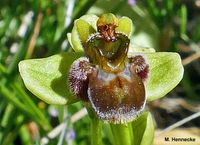Ophrys bombyliflora Link, J. Bot. (Schrader) 2: 325 (1799, pub. 1800)
LSID: 647801-1
WCSP: accepted
GBIF: accepted
NG: https://naturgucker.de/?art=-1876312484
Synonyms/Synomyme
Arachnites bombyliflorus (Link) death., Orchid. Sicul.: 91 (1842).
Ophrys bombylifera Willd., Sp. Pl., Ed. 4, 4: 68 (1805).
Ophrys canaliculata Viv., Fl. Cors. Prodr., App.: 7 (1825).
Ophrys distoma Biv., Sicul. Pl. 1: 59 (1806).
Ophrys hiulca Sebast. & Mauri, Roman. Pl. Cent. xiii: 43 (1820).
Ophrys insectifera var. biflora Desf., Fl. Atlant. 2: 320 (1799).
Ophrys labrofossa Bread., Phytogr. Lusitan. Select. 2: 29 (1827, publ. 1835).
Ophrys pulla Ten., Fl. Napol. 1 (Prodr.): LIII (1813).
Ophrys tabanifera Willd., Sp. Pl., Ed. 4, 4: 68 (1805).
Notabene
Ophrys bombyliflora Spreng. is a synonym of Ophrys fuciflora (F.W. Schmidt) Moench.
Diagnosis/Diagnose
First description of Ophrys bombyliflora by Link (1799).
Terra typica
Portugal: around Tavira in Algarvia.
Type
Holotype: 1798, leg. J.H.F. Link & J.C. Hoffmannsegg (Isot.: W)
Oldest illustration
Probably those of Reichenbach (1830) as Ophrys tabanifera. His plants cited as O. bombyliflora under 1160 and 1161 show an appendage pointing upwards/forwards (Hennecke 2021).
Etymology of the species epithet
bombylis (lat.) = doll of the silk moth (Bombyx mori L.) and flora (lat.) = goddess of flowers.
Possible confusion
None
Variability
The species is very stable. Only three varieties have been descriped yet:
- var. parviflora (LSID: 77144703-1) *
- var. albarranii (LSID: 77154425-1)
- var. canariensis (G. Kunkel) Hennecke (LSID: 77297535-1)**
* Mifsud (2014) upgraded the small-flowered Ophrys bombyliflora on Malta to a variety.
** Stefan Munzinger saw Ophrys bombyliflora in the Canary Islands and found no differences to the other European plants (oral communication), ditto Paulus (1999: 16). The subspecies is therefore downgraded to a variety, especially since Kunkel did not give a diagnosis in Latin or a type, which is the reason probably that the name is not valid at all.
The three varieties mentioned above should rather be classified taxonomically as forma, so they are not described in more detail here, nor f. buccheriana (LSID: 919043-1) and f. elongata (A.Terrac., Boll. Soc. Bot. Ital. 1910: 19.1910).
Flowering phenology
Fruit set/Fruchtansatz
21.3% (Neiland & Wilcock 1998)
Pollinator insects
Kullenberg et al. (1984) listed 10 possible Eucera species as pollinators for Ophrys bombyliflora, Cingel (1995) even 12 and one Tetralonia species, see also Baumann & Baumann (2007), which meticulously list the different pollinators according to region and species. Bateman (2012) names a pollinator number of 11. Paulus (1999) also names a whole range of pollinators, also separated by region. Here it becomes very clear that Ophrys bombyliflora can be pollinated by different insects, which is why a list, which is not complete, is dispensed with.
Chromosome number/Chromosomenzahl
x = 18, 2n = 2x = 36 (Greilhuber & Ehrendorfer 1975, Mrkvicka 1992, CCDB)
Ecology
Sparse forest, garrigue, roadside slopes, grasslands, pesticide-free, uncultivated olive groves and wet meadows, salt meadows, dry to very wet, chalky soil.
Altitude distribution/Höhenverbreitung
General distribution
Observation map of Ophrys bombyliflora (blue: NG; yellow-brown: GBIF: 2020-03).



